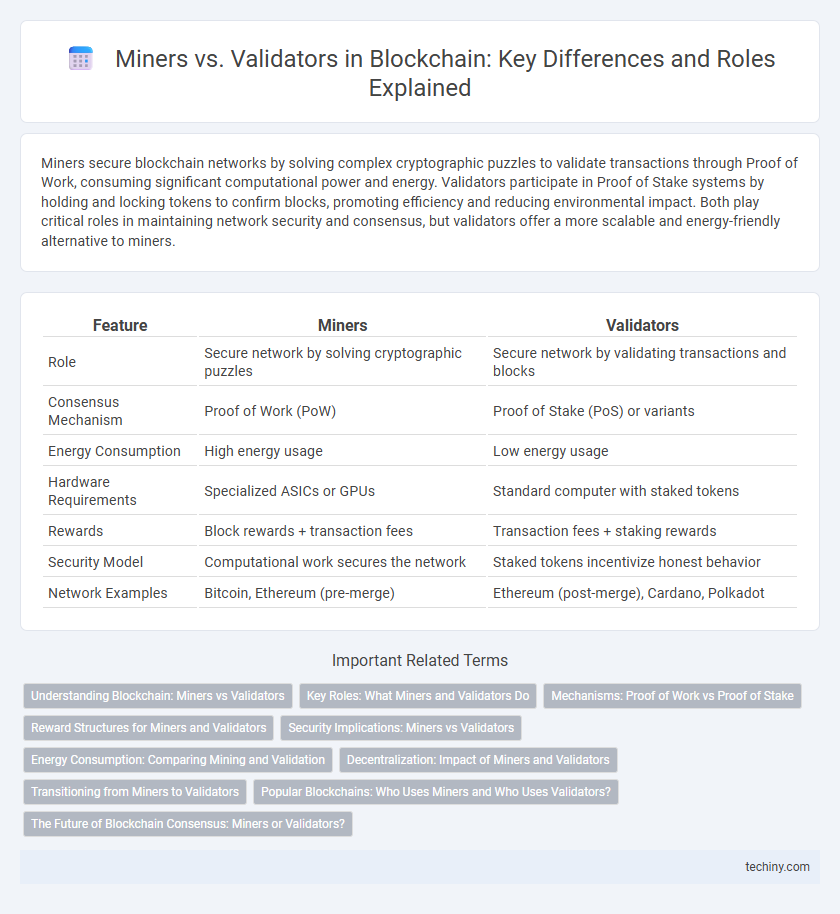Miners secure blockchain networks by solving complex cryptographic puzzles to validate transactions through Proof of Work, consuming significant computational power and energy. Validators participate in Proof of Stake systems by holding and locking tokens to confirm blocks, promoting efficiency and reducing environmental impact. Both play critical roles in maintaining network security and consensus, but validators offer a more scalable and energy-friendly alternative to miners.
Table of Comparison
| Feature | Miners | Validators |
|---|---|---|
| Role | Secure network by solving cryptographic puzzles | Secure network by validating transactions and blocks |
| Consensus Mechanism | Proof of Work (PoW) | Proof of Stake (PoS) or variants |
| Energy Consumption | High energy usage | Low energy usage |
| Hardware Requirements | Specialized ASICs or GPUs | Standard computer with staked tokens |
| Rewards | Block rewards + transaction fees | Transaction fees + staking rewards |
| Security Model | Computational work secures the network | Staked tokens incentivize honest behavior |
| Network Examples | Bitcoin, Ethereum (pre-merge) | Ethereum (post-merge), Cardano, Polkadot |
Understanding Blockchain: Miners vs Validators
Miners and validators are crucial components in blockchain networks, ensuring transaction integrity and network security through different consensus mechanisms. Miners use proof-of-work (PoW) to solve complex mathematical puzzles, earning rewards by adding new blocks to the blockchain, while validators participate in proof-of-stake (PoS) systems, confirming transactions based on the stake of cryptocurrency they hold. Understanding these roles highlights the transition from energy-intensive mining to more efficient, scalable validation processes in modern blockchain architectures.
Key Roles: What Miners and Validators Do
Miners secure blockchain networks by validating and recording transactions through complex computational processes known as proof-of-work, ensuring network integrity and preventing double-spending. Validators participate in proof-of-stake protocols by verifying transactions and creating new blocks based on their stake, promoting energy efficiency and faster transaction processing. Both miners and validators play essential roles in maintaining decentralized consensus and safeguarding the blockchain ledger.
Mechanisms: Proof of Work vs Proof of Stake
Miners secure blockchain networks using the Proof of Work (PoW) mechanism, which requires solving complex cryptographic puzzles to validate transactions and add new blocks. Validators operate under the Proof of Stake (PoS) system, where they are chosen to create new blocks based on the amount of cryptocurrency they stake as collateral. PoW demands substantial computational energy, while PoS emphasizes stake-based selection, reducing energy consumption and increasing network scalability.
Reward Structures for Miners and Validators
Miners in proof-of-work blockchains earn rewards through block subsidies and transaction fees, incentivizing computational power for secure transaction validation. Validators in proof-of-stake systems receive rewards proportional to their staked tokens and participation in consensus, promoting energy efficiency and network stability. Both reward structures align economic incentives with network security but differ in resource consumption and scalability impact.
Security Implications: Miners vs Validators
Miners in proof-of-work blockchains secure the network by solving complex cryptographic puzzles, making attacks computationally expensive and network manipulation difficult. Validators in proof-of-stake systems maintain security by locking up cryptocurrency as collateral, aligning economic incentives to deter malicious behavior and enable faster consensus. The key security implication is that while miners' resource-intensive process ensures robust protection through energy consumption, validators rely on stake penalties and economic game theory to maintain network integrity.
Energy Consumption: Comparing Mining and Validation
Miners in Proof of Work (PoW) blockchains consume vast amounts of energy due to solving complex cryptographic puzzles, exemplified by Bitcoin's network using over 100 terawatt-hours annually. Validators in Proof of Stake (PoS) systems require significantly less energy, as they secure the network by staking tokens rather than performing energy-intensive computations. This shift from mining to validating drastically reduces carbon footprints and operational costs in blockchain consensus mechanisms.
Decentralization: Impact of Miners and Validators
Miners in Proof-of-Work (PoW) networks rely on computational power, often leading to mining pools that concentrate influence and reduce decentralization. Validators in Proof-of-Stake (PoS) systems secure the network by staking tokens, encouraging broader participation and improved decentralization through lower entry barriers. The shift from miners to validators generally enhances network decentralization by distributing decision-making power more evenly across diverse participants.
Transitioning from Miners to Validators
Transitioning from miners to validators marks a fundamental shift in blockchain consensus mechanisms, moving from energy-intensive Proof of Work (PoW) to the more sustainable Proof of Stake (PoS) models. Validators are selected based on the amount of cryptocurrency they hold and lock up as collateral, which drastically reduces the computational power and electricity consumption required for block validation. This transition enhances network efficiency, security, and scalability while promoting eco-friendly practices in blockchain technology.
Popular Blockchains: Who Uses Miners and Who Uses Validators?
Bitcoin and Ethereum (pre-2.0) rely on miners using Proof of Work (PoW) consensus, where computational power secures the network and validates transactions. In contrast, blockchains like Cardano, Polkadot, and Ethereum 2.0 utilize validators through Proof of Stake (PoS), where participants stake tokens to propose and verify new blocks. This shift to validators offers increased energy efficiency and scalability compared to traditional mining-based systems.
The Future of Blockchain Consensus: Miners or Validators?
The future of blockchain consensus is shifting from traditional miners to validators as networks adopt Proof of Stake (PoS) mechanisms, significantly reducing energy consumption and increasing transaction speed. Validators, unlike miners, are selected based on stake ownership rather than computational power, promoting a more secure and decentralized system. This transition highlights a fundamental change in network validation that prioritizes scalability, sustainability, and economic efficiency.
Miners vs Validators Infographic

 techiny.com
techiny.com